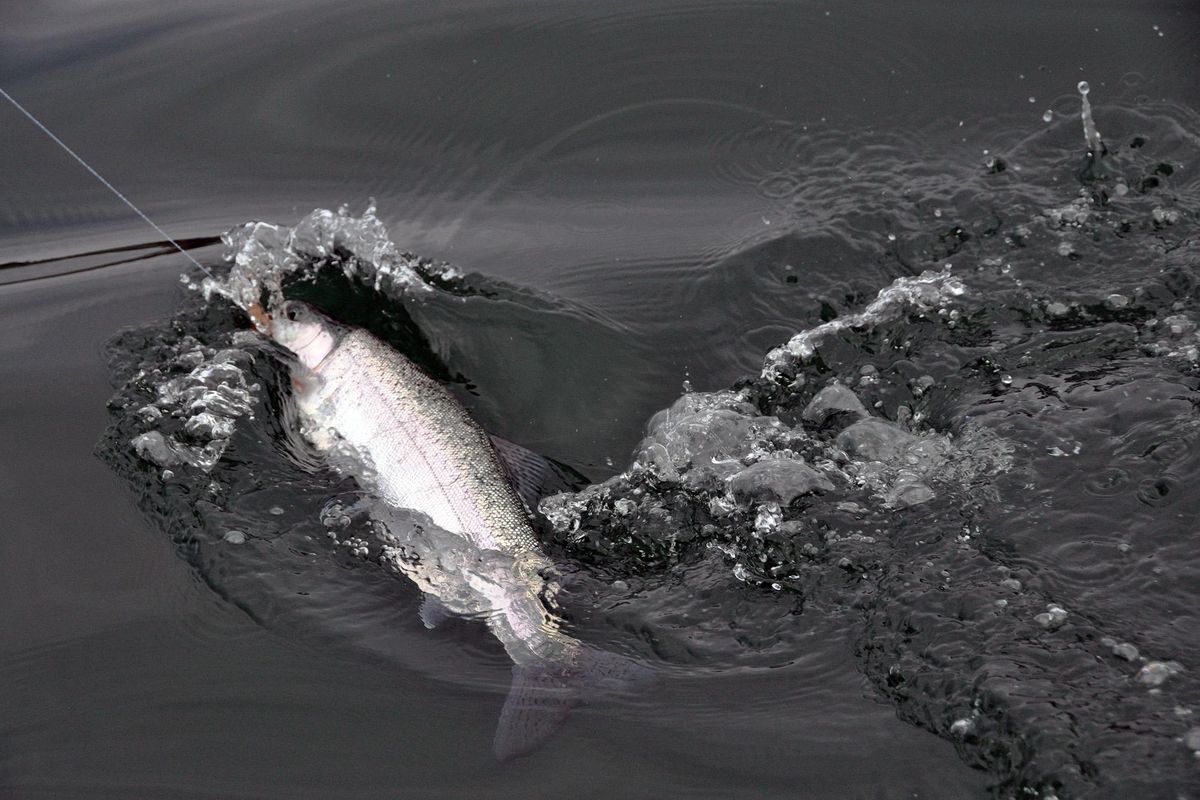Lake Roosevelt trout released from net pens earlier than preferred

Signs of stressed and dying fish caused fish managers to release trout earlier than desired from some of the net pens scattered along Lake Roosevelt this week.
Thousands of 9-inch-long trout were released about a week or two earlier than preferred from net pens where the hatchery rainbows have been fed and raised since October.
“There’s some fungus going on; not a big deal,” said Mitch Combs, Washington Department of Fish and Wildlife Sherman Creek Hatchery manager. “It’s not a disease. It’s not a problem for fishermen.”
Hundreds of dead fish floating near the pens at Two Rivers Marina and Seven Bays caused people to be alarmed, he said.
“It looks bad and people get upset when they see dead fish,” said Gene Smith of Seven Bays, who has been involved with the net-pen rearing project since the 1990s. “The staff was hustling to take care of the fish and the dead ones didn’t get dipped out like we normally do.
The water temperature around the nets rose to about 60 degrees, “which is unusually warm for this time of year,” Smith said.
“The fish are bigger and about three times the size and density in the pens from when they were put in there last fall. Things can happen.”
“That’s why we watch the fish in the nets regularly,” said Chris Donley, Fish and Wildlife’s regional fisheries manager. “If they get sick, we turn them loose. Once they spread out into the lake, the problem resolves.”
The net-pen project, which is funded by the Bonneville Power Administration and supported by numerous volunteers, normally raises 700,000-750,000 rainbow trout for release to support the popular fishery in the 150-mile-long reservoir.
The net pens offer good survival rates for rearing a crop of fish that otherwise would far exceed available hatchery space.
The trout are hatched at the Spokane Tribal hatchery in December and raised there at Sherman Creek Hatchery to about 3 inches long until they are stocked in 65 net pens for rearing.
The pens are at Keller, Lincoln, Seven Bays, Two Rivers, Hunters, Hall Creek, Kettle Falls and Sherman Creek. Volunteers service 45 of the pens.
Last year’s drought conditions prompted fish managers to reduce the number of net pen fish to 600,000 to give them more space and less stress in the warmer-than-normal water temperatures, Combs said.
Lake Roosevelt is drawn down each year – sometimes dramatically – to accommodate anticipated spring runoff coming down the Columbia River. The net pens require frequent adjusting when water levels are changing.
“We try to hold the fish in the pens until the drawdown is over and the reservoir has refilled to an elevation of 1,260 feet or above,” Combs said. Full pool is 1,290 feet.
“Studies have shown that we get 10 times more fish back to the creel if we hold the fish to 1,260 – that’s huge!
So we’re willing to chance keeping the fish in the pens a little longer because even if we lose some fish the benefits outweigh those losses.”
A higher percentage of the trout are flushed out of the reservoir over Grand Coulee Dam if the trout are too small or the net pens are emptied too soon, he said.
The Bureau of Reclamation began refilling the reservoir on May 8 from a low of about 1,243 feet.
The level was under 1,255 feet when the first net pen fish were released and up to 1,258 on Tuesday, with net tenders reporting they had released fish from 41 of the 65 pens.
“We’ve been sweating it out a little, but the benefits of holding the fish a few more days are worth it,” Combs said.
Hatcheries are always losing a small percentage of fish and so do the net pens, he said.
“Out of about 160,000 fish in the pens we opened up, we lost about 3,000 over time,” he said. “That sounds like a lot, but we more than make up for it if we can hold fish to 1,260.”
For best survival rates the rainbows are raised to a size of about 9 inches long, or five to the pound.
He said the fish that die are food for the reservoir system. “But 90 percent of the fish we raise are living to be big enough to survive and be available to anglers,” he said.
“We’ve had some good years recently. Our goal isn’t to have a great year based on water flows but to have great fisheries consistently.”